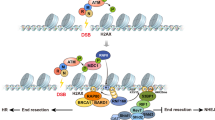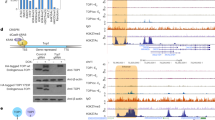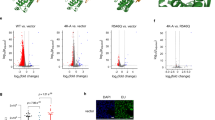Abstract
Reconstituted transcription reactions containing the seven general transcription factors, in addition to RNA polymerase II, respond poorly to transcriptional activators. Two factors, Dr2 and ACF, necessary for high levels of transcription in response to an activator have been identified. ACF can enhance basal and activated transcription. Dr2 represses basal transcrip-tion, but this can be overcome by transcriptional activators or TFIIA. Dr2 is human DNA topoiso-merase I. The DNA relaxation activity of topoisomerase I is dispensable for transcriptional repression. The effect of Dr2 is specific for TATA-box-containing promoters and is mediated by the TATA-binding protein.
This is a preview of subscription content, access via your institution
Access options
Subscribe to this journal
Receive 51 print issues and online access
$199.00 per year
only $3.90 per issue
Buy this article
- Purchase on SpringerLink
- Instant access to full article PDF
Prices may be subject to local taxes which are calculated during checkout
Similar content being viewed by others
References
Ptashne, M. & Gann, A. F. Nature 346, 329–331 (1990).
Zawel, L. & Reinberg, D. Progress in Nucleic Acid Research and Molecular Biology Vol. 44 (eds Cohn, W. E. & Moldave, K.) 67–108 (Academic, San Diego, 1993).
Lin, Y. S., Ha, I., Maldonado, E., Reinberg, D. & Green, M. R. Nature 353, 569–571 (1991).
Ingles, C. J., Shales, M., Cress, W. D., Triezenberg, S. J. & Greenblatt, J. Nature 351, 588–590 (1991).
Roberts, S. G. E., Ha, I., Maldonado, E., Reinberg, D. & Green, M. R. Nature 363, 741–744 (1993).
Lin, Y.-S., Carey, M. F., Ptashne, M. & Green, M. R. Cell 54, 659–664 (1988).
D'Arpa, P. et al. Proc. natn. Acad. Sci. U.S.A. 85, 2543–2547 (1988).
Liu, L. F. & Miller, K. G. Proc. natn. Acad. Sci. U.S.A. 78, 3487–3491 (1981).
Madden, K. R. & Champoux, J. J. Cancer Res. 52, 525–532 (1992).
Eng, W., Pandit, S. D. & Sternglanz, R. J. biol. Chem. 164, 13373–13376 (1989).
Lynn, R. M., Bjornsti, M., Caron, P. R. & Wang, J. C. Proc. natn. Acad. Sci. U.S.A. 86, 3559–3563 (1989).
Wang, J. A. Rev. Biochem. 54, 665–697 (1985).
Weis, L. & Reinberg, D. FASEB J. 6, 3300–3309 (1992).
Cortes, P., Flores, O. & Reinberg, D. Molec. cell. Biol. 12, 413–421 (1992).
Zhou, Q., Lieberman, P. M., Boeyer, T. G. & Berk, A. J. Genes Dev. 6, 1964–1974 (1992).
Buratowski, S., Hahn, S., Guarente, L. & Sharp, P. A. Cell 56, 549–561 (1989).
Maldonado, E., Ha, I., Cortes, P., Weis, L. & Reinberg, D. Molec. cell. Biol. 10, 6335–6347 (1990).
Berger, S. L. et al. Cell 70, 251–265 (1992).
Kelleher, R. J. I., Flanagan, P. M. & Kornberg, R. D. Cell 61, 1209–1215 (1990).
Lewin, B. Cell 61, 1161–1164 (1990).
Gill, G. & Tjian, R. Curr. Opin. Genet. Dev. 2, 236–242 (1992).
Seto, E. et al. Proc. natn. Acad. Sci. U.S.A. 89, 12028–12032 (1992).
Mack, D. H., Vartikar, J., Pipas, J. M. & Laimins, L. A. Nature 363, 281–283 (1993).
Choder, M. Genes Dev. 5, 2315–2326 (1991).
Fleischmann, G. et al. Proc. natn. Acad. Sci. U.S.A. 81, 6958–6962 (1984).
Stewart, A. F., Herrera, R. E. & Nordheim, A. Cell 60, 141–149 (1990).
Liu, L. F. & Wang, J. C. Proc. natn. Acad. Sci. U.S.A. 84, 7024–7027 (1987).
Thrash, C., Bankier, A. C., Barrel, B. G. & Sternglanz, R. Proc. natn. Acad. Sci. U.S.A. 82, 4374–4378 (1985).
Goto, T. & Wang, J. C. Proc. natn. Acad. Sci. U.S.A. 82, 7178–7182 (1985).
Lee, P. L., Brown, S. D., Chen, A. & Hsieh, T.-H. Proc. natn. Acad. Sci. U.S.A. 90, 6656–6660 (1993).
Inostroza, J. A., Mermelstein, F. H., Ha, I., Lane, W. S. & Reinberg, D. Cell 70, 477–489 (1992).
Meisterenst, M. & Roeder, R. G. Cell 67, 557–567 (1991).
Meisterenst, M., Roy, A. L., Lieu, H. M. & Roeder, R. G. Cell 66, 981–993 (1991).
Laybourn, P. J. & Kadonaga, J. K. Science 254, 238–245 (1991).
Workman, J. L., Taylor, I. C. A. & Kingston, R. E. Cell 64, 533–544 (1991).
Croston, G. E., Kerrigan, L. A., Lira, L. M., Marshak, D. R. & Kadonaga, J. T. Science 151, 643–649 (1991).
Croston, G. E., Laybourn, P. J., Paranjape, S. M. & Kadonaga, J. T. Genes Dev. 6, 2270–2281 (1992).
Lu, H., Flores, O., Weinmann, R. & Reinberg, D. Proc. natn. Acad. Sci. U.S.A. 88, 10004–10008 (1991).
Chasman, D. I., Leatherwood, J., Carey, M., Ptashne, M. & Kornberg, R. D. Molec. cell. Biol. 9, 4746–4749 (1989).
Lillie, J. W. & Green, M. R. Nature 338, 39–44 (1989).
Tanese, N., Pugh, B. F. & Tijian, R. Genes Dev. 5, 2212–2224 (1991).
Ha, I., Lane, W. S. & Reinberg, D. Nature 352, 689–695 (1991).
Shuman, S. J. biol. Chem. 266, 1796–1803 (1991).
Srivenugopal, K. S., Lockshon, D. & Morris, D. R. Biochemistry 23, 1899–1906 (1984).
Liu, F. & Green, M. R. Cell 61, 1217–1224 (1990).
Merino, A., Buckbinder, L., Mermelstein, F. H. & Reinberg, D. J. biol. Chem. 264, 21266–21276 (1989).
Pugh, B. F. & Tjian, R. Cell 61, 1187–1197 (1990).
Author information
Authors and Affiliations
Rights and permissions
About this article
Cite this article
Merino, A., Madden, K., Lane, W. et al. DNA topoisomerase I is involved in both repression and activation of transcription. Nature 365, 227–232 (1993). https://doi.org/10.1038/365227a0
Received:
Accepted:
Issue date:
DOI: https://doi.org/10.1038/365227a0
This article is cited by
-
Transcriptional repression by a secondary DNA binding surface of DNA topoisomerase I safeguards against hypertranscription
Nature Communications (2023)
-
Screening for natural inhibitors of human topoisomerases from medicinal plants with bio-affinity ultrafiltration and LC–MS
Phytochemistry Reviews (2020)
-
Roles of eukaryotic topoisomerases in transcription, replication and genomic stability
Nature Reviews Molecular Cell Biology (2016)
-
Transcription-generated torsional stress destabilizes nucleosomes
Nature Structural & Molecular Biology (2014)
-
Design and development of topoisomerase inhibitors using molecular modelling studies
Journal of Chemical Biology (2013)



